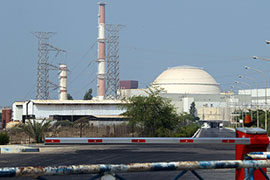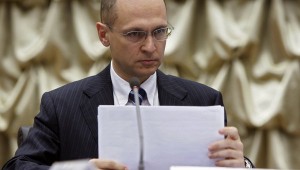 Iran has started loading fuel into its first Russian-built nuclear power plant.
Iran has started loading fuel into its first Russian-built nuclear power plant.
After decades of delay, engineers finally began loading the Russia-supplied fuel into the Bushehr plant in southern Iran on Saturday.
The development is a major milestone in Iran’s atomic program despite UN sanctions.
The transfer took place under the scrutiny of International Atomic Energy Agency [IAEA] inspectors, according to a statement by Iran’s atomic energy organization.

“The operation of transferring nuclear fuel to the reactor was carried out in [the] presence of Ali Akbar Salehi, vice-president and head of Iran’s atomic body, and Sergei Kiriyenko, head of Russia’s atomic body, Rosatom,” it said.
Al Jazeera’s Neave Barker, reporting from Moscow, said it will take “several months before the plant is up and running fully and, according to Rosatom, Russia will continue to play an active role in the running of the plant for several more years.”
“Today we begin the physical launch of the Bushehr power plant in Iran,” Kiriyenko told a launch ceremony.
“The fuel is being put in the reactor chamber. From now on the reactor is an [operational] nuclear power plant,” Kiriyenko said.
He stressed that the reactor can only be used for civilian purposes.
Fuel ‘pool’
A first lorry-load of fuel was taken from a storage site to a fuel “pool” inside the reactor building on Saturday.
Over the next 10 days, 163 fuel rods – equal to 80 tonnes of uranium fuel – will be moved inside the building and then into the reactor core “after necessary inspections”, the statement said.
in depth
The $1bn plant’s 1,000-megawatt light-water reactor will pump electricity to Iranian cities.
Last week, Salehi said the fuel transfer would be complete by September 5.
Last week, Salehi said the fuel transfer would be complete by September 5.
Iran plans to build 10 new uranium enrichment sites inside protected mountain strongholds.
According to Iranian officials, construction on the first one will begin in March in defiance of the UN sanctions.
Nationwide celebrations were planned for Saturday’s fuel loading at Bushehr.
Ali Shirzadian, the spokesman for the Iranian atomic energy organization, said on Friday that the plant’s actual commissioning would come in October or November when the electricity it generates connects to the national grid.
The launch comes despite the fact that Russia, a long-time nuclear ally, has toughened its stance on Iran’s nuclear programme.
In June, Russia backed a fourth round of UN sanctions against Iran over its uranium enrichment, the most controversial part of its atomic programme and which the West believes is aimed at making nuclear weapons, a charge the country strongly denies.
Iran has said it is enriching uranium to power nuclear reactors so it can eventually generate electricity of around 20,000MW.
Energy exporter
Despite being the world’s second-largest exporter of crude oil and having the world’s second largest gas reserves, Iran insists it needs nuclear power for when its fossil fuels eventually run out.
Salehi, the Iranian atomic-body head, said on Friday that Iran will continue enriching uranium to make fuel for the Bushehr plant as the country might not always buy it from Moscow.
“The Bushehr plant has a life span of 60 years and we plan to use it for 40 years. Suppose we buy fuel for 10 years from Russia. What are we going to do for the next 30 to 50 years?” the state news agency, IRNA, quoted him as saying.
Russia has already supplied 82 tonnes of fuel for Bushehr and plans to take back the spent material to avoid any misuse.
Sergei Lavrov, the Russian foreign minister, said on Wednesday the Bushehr plant would keep Iran firmly fixed to the peaceful use of nuclear power.
“It is a most important anchor which keeps Iran within the regime of non-proliferation,” he said.
Mark Fitzpatrick, an expert in non-proliferation at the International Institute for Strategic Studies in London, said Bushehr is not a proliferation risk “as long as it is run to produce power for electricity generation”.
“It would be a risk if Iran operated it differently, for short periods at low-burn up in order to produce weapons-usable plutonium – but in this case the IAEA would know,” he said, referring to the UN atomic watchdog.
Shah-era project
Work on the Bushehr plant, which is not targeted under UN or other sanctions, began in the 1970s under the rule of the Shah Mohammed Reza Pahlavi, the US-backed deposed ruler, using contractors from Siemens, the German firm.
The Bushehr project was put on hold when the shah was toppled in the 1979 Islamic revolution, and was revived a decade later under Ali Khamenei, the current supreme leader.
The Bushehr plant is not considered a proliferation risk because the terms of the deal commit the Iranians to allowing the Russians to retrieve all used reactor fuel for reprocessing.
Spent fuel contains plutonium, which can be used to make atomic weapons.
Additionally, Iran has said that IAEA experts will be able to verify that none of the fresh fuel or waste is diverted.
“The real test of trust for the opening of Bushehr is whether or not Iran will agree to send those fuel rods back and honour its contract in the coming years,” our correspondent said.
In 1994, Russia agreed to complete its construction, but since then “technical problems” and disputes between Moscow and Tehran delayed its completion.
Fresh doubts over Bushehr were raised after Moscow voted for the latest UN sanctions, followed by comments made by Dmitry Medvedev, the Russian president, that Iran was close to attaining the potential to build a nuclear weapon.
This triggered an angry response from Iran, as Moscow’s position has always been that Tehran has the right to peaceful nuclear energy.
Ali Asghar Soltanieh, Iran’s envoy to the IAEA, accused Moscow of delaying Bushehr’s start-up, saying “it is hard to believe that the technical issues continue to delay the completion of the plant over the past 15 years”.
Bushehr has always been seen as a potential target in the event of a military attack by the US and Israel, who have never ruled out military action against Iran’s nuclear program. Aljazeera
Leave a Reply
You must be logged in to post a comment.